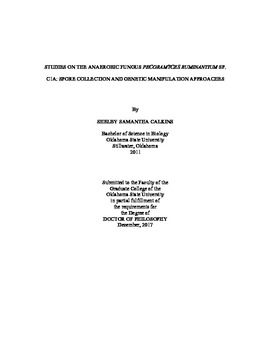| dc.contributor.advisor | Youssef, Noha H. | |
| dc.contributor.author | Calkins, Shelby Samantha | |
| dc.date.accessioned | 2018-06-18T16:02:30Z | |
| dc.date.available | 2018-06-18T16:02:30Z | |
| dc.date.issued | 2017-12 | |
| dc.identifier.uri | https://hdl.handle.net/11244/300084 | |
| dc.description.abstract | The overall aim of this dissertation is to develop means for spore collection and growth synchronization, long-term storage, and gene knockdown protocols in the anaerobic gut fungal isolate Pecoramyces ruminantium strain C1A (C1A). A novel technique for the growth of strain C1A on agar medium in serum bottles and subsequently flooding the observed aerial growth to promote spore release from sporangia into the flooding suspension was developed. This surface growth-aerial flooding approach was to achieve three different goals hitherto unfeasible in strain C1A liquid cultures. First, surface growth was shown to be an excellent cryopreservative- and freezing temperatures-free approach for AGF long-term storage, and the utility of the approach was verified in multiple strains in addition to strain C1A. Second, the developmentally synchronized C1A spores collected allowed for real time PCR (RT-PCR) transcriptional analysis of focal adhesion (FA) genes at various stages of development. This study showed for the first time that FA scaffolding proteins are indeed transcribed during growth in the absence of an extracellular matrix anchor, suggesting an alternative function for such proteins in the anaerobic gut fungi and hence highlighting the diverse functionalities of FA scaffolding proteins in basal fungi. Finally, the collected spores were shown to be naturally competent, and such ability was exploited to develop and optimize an RNA interference (RNAi)-based protocol for targeted gene silencing in C1A. Germinating C1A spores readily uptook chemically-synthesized small interfering RNA (siRNA) oligonucelotides coding for the D-lactate dehydrogenase (ldhD) gene resulting in marked target gene silencing; as evident by significantly lower ldhD transcriptional levels, a marked reduction in the D-LDH specific enzymatic activity in intracellular protein extracts, and a reduction in D-lactate levels accumulating in the culture supernatant. Collectively, results from these studies have opened the door not only for developmental biology studies, but also for targeted gene manipulations in this understudied fungal clade. | |
| dc.format | application/pdf | |
| dc.language | en_US | |
| dc.rights | Copyright is held by the author who has granted the Oklahoma State University Library the non-exclusive right to share this material in its institutional repository. Contact Digital Library Services at lib-dls@okstate.edu or 405-744-9161 for the permission policy on the use, reproduction or distribution of this material. | |
| dc.title | Studies on the anaerobic fungus Pecoramyces ruminantium sp. C1A: Spore collection and genetic manipulation approaches | |
| dc.contributor.committeeMember | Elshahed, Mostafa S. | |
| dc.contributor.committeeMember | Shaw, Edward I. | |
| dc.contributor.committeeMember | Prade, Rolf A. | |
| dc.contributor.committeeMember | Marek, Stephen M. | |
| osu.filename | Calkins_okstate_0664D_15459.pdf | |
| osu.accesstype | Open Access | |
| dc.type.genre | Dissertation | |
| dc.type.material | Text | |
| thesis.degree.discipline | Fungal Biology | |
| thesis.degree.grantor | Oklahoma State University | |
